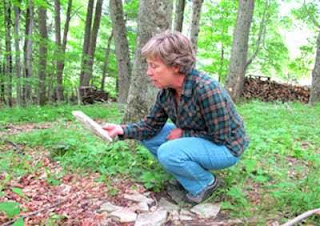A wire fence, a wood pile, a stand of maples strewn with stones, a dog meandering up with a half-hearted warning bark -- we could be one of countless places along a Vermont back road. Historian Elise Guyette knows better. The dog, for one, is friendly and so is the landowner, familiar from Guyette's previous visits to this spot just east of the crest of Lincoln Hill Road in Hinesburg. She steps around the fence and into the past, pointing out a rough stone that likely marks a grave, picking up broken shards of a tombstone, etchings of a weeping willow, perhaps, still visible. Known to locals for years as "the old negro burying ground," the Clark family plot is at the heart of the acreage where an African American community of farm families pioneered the land and made their living in the eighteenth and nineteenth centuries.
"Standing here and seeing the stones and knowing where I was and that nobody knew anything about them, that's what amazed me," Guyette says while discussing the research process of her recently published book. "A lot of people around here know this is a cemetery, know this was a black cemetery, they've known this forever -- but nobody knew one thing about the people who lived here."
Not only did they make it, but they thrived - as far as that word can apply to a rocky Vermont hill farm. Together with the Peters families who would settle land lower on the hill three years later, the African American community grew to at least eight families. Guyette's research suggests that, particularly in the early years, farmers' need for a strong community to weather the rigors of pioneer life sometimes trumped racism. In such circumstances, valley people versus hill people, might have been viewed as a starker division than black versus white.
But the challenges of later years are suggested by the fact that the history of this community has been so long hidden. One descendant told Guyette, "See they came from the time period where black people were seen as second-class people, and they were treated poorly and tormented by other children, and those hurt feeling don't go away and never will."
With no direct family journals or diaries to work from, Guyette found the collective history of the families on the hill through painstaking research. She spent hour upon hour in local town clerks offices and libraries, pouring over documents from tax records to store ledgers to accounts of estate sales for glimpses of their lives.
"I didn't know if I'd be able to find a shred of evidence that they had lived here," says Guyette, who earned her bachelor's from UVM in 1971 and added two master's degrees and a doctorate in later years. "You sit there and you keep turning the pages, and then when you find something you're like, (she whispers) 'Oh, god, thank you,' then you start taking notes. I kept coming back and coming back, finding more and more stuff. I couldn't believe how much was in the records about these people. I just knew at some point that this was more than an article; this was a book."
A richer history
Though Guyette's research was years in the making, the motivation pushing her was built over deacades. Growing up in a rich cultural mix of Rutland, Vermont, her own family of French-Lebanese-Irish descent, Guyette recalls being a fourth grader eager for a Vermont history unit -- "I couldn't wait to read about all of the people around me." Instead, she was handed a standard text of political leaders and war heroes -- decidedly white, male, and protestant.
Years later, as a teacher in Swanton, Vt., Guyette was given the very same pale little volume as a teaching resource. But what she had quietly accepted as a child and a student, was not going to do as an adult and a teacher. Not long after, she set to work on a Vermont history for young people that would include all of the different ethnic groups. The result of that work was Vermont: A Cultural Patchwork, published in 1986.
Guyette's path as a historian would take a distinct turn toward the hill in Hinesburg when she was working on her master's thesis in history. She set her sights on the experience of blacks in Vermont as a little-studied area. Originally, accepting the conventional wisdom, she believed the story of blacks in Vermont would not go much beyond the Underground Railroad. Hoping to find background on this connection, she visited Tom Bassett, longtime UVM archivist and Vermont historian, at his home.
Bassett had nothing to offer on the Underground Railroad, but he had something better --basic research he had done for his brother, a sociologist, in which he had gone through past census reports and written down the names of every black person he could find. The shoe box was stuffed full of index cards, each with a name. Guyette says, "It was like it was waiting for me."
Now that her book is published and a green Vermont historic marker titled "Early Black Settlers" is planted where Lincoln Hill Road bends east off North Road, Guyette hopes that her long research and writing process will help to change perceptions about the diversity of Vermont's cultural history. As she writes in the introduction to her book, perhaps the most important aspect of this story is its most fundamental fact -- "the revelation that such a place as this hill existed."
Release Date: 07-20-2010
Author: Thomas James Weaver Email: Thomas.Weaver@uvm.edu Phone: 802/656-7996 Fax: (802) 656-3203
















No comments:
Post a Comment